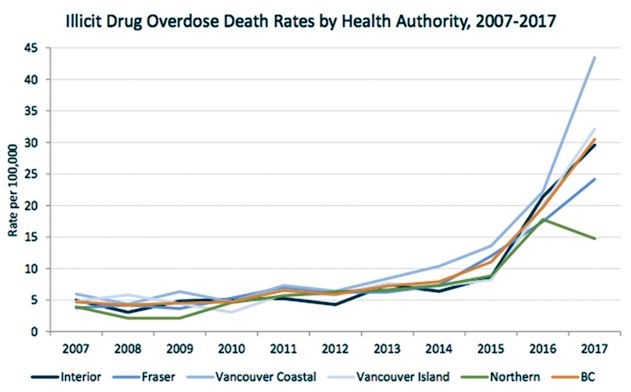While the number of deadly drug overdoses is soaring across the rest of the province, the Northern Health region is the only area in B.C. reporting a decrease for 2017 so far, according to the latest report from the B.C. Coroners Service.
The study, which includes confirmed and suspected illicit overdose deaths, shows there were 136 suspected drug overdose deaths across B.C. in April 2017, while in April 2016 there were 69.
That's a 97.1 per cent increase.
There has been 488 deaths in B.C. so far this year. Most were people between the ages of 30 and 49 years old, and four out of five of those who died were men. Of the 488 deaths, just 14 took place within Northern Health region.
Last year, there was 935 overdose deaths in B.C., 50 of them in the Northern Health region, which covers the entire northern half of the province, from Quesnel north to the Yukon border. Nine out of 10 illicit drug overdose deaths took place indoors, including more than half in private residences.
No deaths occurred at any supervised consumption sites or any other overdose prevention sites, the study said.
"It is of great concern that despite the harm-reduction measures now in place and the public-safety messages issued, many people are still using illicit drugs in private residences where help is not readily available," Lisa Lapointe, chief coroner said in a press release Wednesday.
"I strongly urge those using illicit drugs to do so only at a safe consumption site or drug overdose prevention site, if one is accessible. If one of these sites is not accessible, please use only a small amount of the drug initially and only in the presence of someone willing and able to administer naloxone and call 911 if required," Lapointe added.
"The risks associated with all illicit drugs in the province are extreme, and access to emergency medical assistance is essential to prevent fatal consequences."
The top four detected drugs in completed cases from 2015 and 2016 saw cocaine at 48.4 per cent, fentanyl at 44.8 per cent, heroin at 36.2 per cent and methamphetamine/amphetamine at 29.3 per cent.
Health Canada drug testing saw fentanyl and its analogues detected in samples of all the other drugs listed and illicit fentanyl detected deaths seem to account for the increase in overdose deaths since 2012 and a reported 61.8 per cent increase was seen in 2016.
For more coverage of the provincial situation, see page 12.



